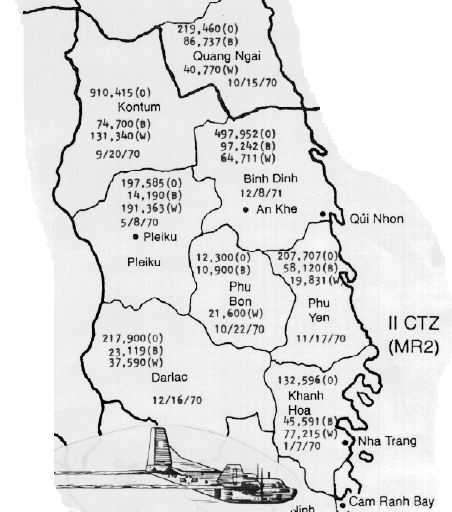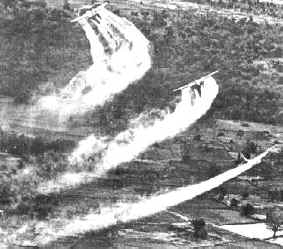"...to care for him who shall
have borne the battle"
Abraham
Lincoln
AGENT ORANGE

C-123
"Provider" similar to the ones
used in Operation Ranch Hand
Photo: 15th webmaster
"Between
1962 and 1971, US military forces sprayed
millions of gallons of herbicides
over South
Vietnam.
Agent Orange accounted for much of the total sprayed."
NAS Press Release - July 28, 1993 [REPORT]
HOT TOPICS
Korea DMZ Vets and Agent Orange [see Announcements page]
NEW STUDY AT COLUMBIA [details]
Agent Orange
Statistics - Statistical Summary
the
Rainbow
herbicides
Herbicides were used by the U.S. during the Vietnam War to defoliate the hiding places of the Viet Cong (VC) guerillas and North Vietnamese Army (NVA) regulars.
The most infamous herbicide used was called Agent Orange. The steel drums in which the herbicide was transported were color-coded with an orange stripe. Other colors such as Blue, White, Purple and Pink, were used to designate different herbicide formulations.
The largest volume of herbicide was applied from the air by C-123 "Provider" twin-engine aircraft. This air spray program was code named Operation Ranch Hand.
Herbicides were also used around the perimeters of fire bases to keep the concertina wire clear of vegetation, providing an open view for sentries on guard duty. Herbicides were also sprayed along river banks to reduce the number of US casualties in the Brown Water Navy.
Below is a map of the provinces of the Central Highlands showing the total volume sprayed of the three major herbicides used in the war; Agents Orange, Blue and White.
NOTE: This map features only the provinces near the 7/15th Field Artillery's area of operations in the II CORPS region of Vietnam. Herbicides were also used in other provinces of Vietnam.
KEY TO MAP
Figures indicate the number of gallons of
herbicide applied during the
Vietnam war.
(O)
Agent Orange
(B)
Agent Blue
(W)
Agent White
Date
indicates the last time herbicides were used in that province.

Also see: Operation
Ranch Hand statistics page
The
Rainbow
Herbicides
HERBICIDECOMPONENTS
WHEN USED
Agent Orange
2,4-D and 2,4,5-T
1/65 - 4/70
Agent Orange II
"Super Orange"
2,4-D and 2,4,5-T
1968 and 1969
Agent Purple
2,4-D and 2,4,5-T
1/62 - 1964
Agent Pink
2,4,5-T
1962 - 1964
Agent Green
2,4,5-T
1962 - 1964
Agent White
Picloram and 2,4-D
Agent Blue
Cacodylic acid (arsenic)
---
Dinoxol
2,4-D and 2,4,5-T
1962 - 1964
Trinoxol
2,4,5-T
1962 - 1964
Diquat
Diquat
1962 - 1964
Bromacil
Bromacil
1962 - 1964
Tandex
Tandex
1962 - 1964
Monuron
Monuron
1962 - 1964
Diuron
Diuron
1962 - 1964
Dalapon
Dalapon
1962 - 1964

Transports fly in close formation as they
spray defoliation chemicals on the jungle
to deprive the enemy of hiding places
HEALTH PROBLEMS
Following the war, veterans began to experience health problems that they attributed to herbicide exposure. Finally, almost 20 years after the war ended, Congress asked the Institute of Medicine (IOM) National Academy of Sciences (NAS) to perform an in-depth study. The length of time that had elapsed since the end of the war certainly didn't help the committee.
On July 28, 1993 the
following Press Release was issued by the Institute of Medicine, National Academy of
Sciences:
REPORT
LINKS DISEASE TO HERBICIDES;
CALLS FOR NEW STUDIES OF EXPOSED
VIETNAM VETERANS
July 28, 1993
WASHINGTON - Evidence exists linking three cancers and two other health problems with
chemicals used in herbicides in the Vietnam War, a committee of the Institute of Medicine
(IOM) has concluded. Those diseases are soft tissue sarcoma, non-Hodgkin's lymphoma,
and Hodgkin's disease, as well as skin diseases chloracne and porphyria cutanea tarda
(PCT). The committee also concluded that new studies piecing together different
types of information could help determine how much the risk of disease is increased in
veterans who were exposed to such herbicides as Agent Orange.
The committee's
report specifically focuses on Agent Orange and other herbicides used in Vietnam, some of
which contained dioxin, and unintended byproduct of the manufacturing process.
"Over the years, extreme views have evolved on the issue," said Harold Fallon,
IOM committee chair and dean of the School of Medicine at the University of Alabama,
Birmingham. "On one extreme is the view that Agent Orange has not led to health
problems. Our committee has determined through an extensive review of the scientific
literature that indeed, there does appear to be a link between exposure to herbicides and
certain diseases."
Most of the evidence
the committee reviewed about adverse health effects came from studies of people who were
exposed as a result of their jobs or from industrial accidents. These types of
exposures often were at high levels and for long periods of time. Getting a clear
picture of the health risks for Vietnam veterans is not so straightforward, the committee
said, because the levels of exposure were extremely wide ranging. Indeed, while most
veterans probably had lower exposure levels, some may have experienced levels as high as
that of occupational or agricultural exposures. What is uncertain is how many
veterans may have been exposed to those higher levels and who those individuals are.
"We simply do not know the degree of risk for Vietnam veterans," said committee
vice chair David Tollerud, director of occupational and environmental medicine, University
of Pittsburgh Graduate School of Public Health. "We do feel, however, that
enough information exists to allow studies to be done that would lead to a better
understanding of the risk that veterans face for contracting diseases related to herbicide
exposure in Vietnam."
ADVERSE HEALTH EFFECTS
The committee examined more than 230 epidemiological studies in detail on a range of health problems and their possible association with herbicides. It found sufficient evidence of a statistical association between exposure to herbicides or dioxin and soft tissue sarcoma, non-Hodgkin's lymphoma, and Hodgkin's disease. The committee also found sufficient evidence of an association between herbicides or dioxin and chloracne and PCT. Chloracne is a specific acne-like skin disorder; PCT is a liver disorder characterized by thinning and blistering of the skin.
The category of sufficient evidence represented the strongest link the committee made between adverse health effects and exposure to herbicides, including Agent Orange or dioxin.
The U.S. Department of Veterans Affairs currently compensates Vietnam veterans for non-Hodgkin's lymphoma, soft tissue sarcoma, and chloracne.
The link between herbicides or dioxin and other adverse health effects the committee studied fell into three remaining categories:
> Limited or Suggestive Evidence. The committee found limited or suggestive evidence of an association between exposure to herbicides of the kind used in Vietnam and three other cancers: respiratory cancers, prostate cancer, and multiple myeloma.
> Inadequate Evidence. The scientific data for most cancers and other diseases, such as adverse neurological and reproductive effects, were inadequate or insufficient to determine whether an association exists, the report says (see attached list).
> No Association. For a small group of cancers, the committee found that a sufficient number and variety of well-designed studies exist to conclude that there is limited or suggestive evidence of no association between these cancers and the herbicides or dioxin. This group includes skin cancer, gastrointestinal tumors (colon, rectal, stomach, and pancreatic), bladder cancer, and brain tumors.
NEW MEASURES OF EXPOSURE NEEDED
In reviewing the literature, the committee found that exposure assessment was the weakest element in most epidemiological studies of veterans. While some studies show a link between adverse health effects and herbicides or dioxin, there are few data indicating which individuals may have received high exposures during service in Vietnam.
The evidence about exposure during the war suggests that Vietnam veterans as a group had substantially lower exposure to herbicides and dioxins than the subjects in many occupational studies, the committee said. Veterans who were participants in Operation Ranch Hand -- the extensive spraying of some 19 million gallons of herbicide over 3.6 million acres of South Vietnam from airplanes -- are an exception to this pattern, however, because of their direct involvement in the spraying missions.
But the committee also said that, among the approximately 3 million Vietnam veterans, there may be some former ground troops not directly involved in the spraying who were exposed to herbicides at levels associated with adverse health effects.
The committee emphasized that it may be possible to develop better exposure measures for Vietnam veterans by relying on "less formal" sources of historical information than have been used in the past. Previous studies have relied primarily on the carefully recorded information on aerial spraying in Operation Ranch Hand and on blood tests for dioxin, but these measures may not reflect the full range of exposures of Vietnam veterans to herbicides.
The committee urged that a non-government organization be commissioned to develop and test new methods of evaluating herbicide exposure in Vietnam veterans. These new methods would draw on historical reconstructions and include information on the spraying that occurred around base camps and other areas which could have led to higher human exposures, the committee said. Important information could be gained from historical records of ground and perimeter spraying, herbicide shipments to various military bases, and knowledge of the type of terrain and foliage typical of the locations sprayed and the military mission of the troops located there. These new methods of measuring exposure should be evaluated by an independent, non-government scientific panel.
If they prove to be valid, a new series of epidemiological studies of veterans should be undertaken to assess the degree to which veterans may be at risk of cancer and other disease as a result of exposure, the committee said.
It also urged continued follow-up of the Ranch Hand veterans and its comparison group, and recommended that members of the Army Chemical Corps also be studied for adverse health effects from exposure. Studies should be done by an independent agency, noting that such an independent body could do much to 'satisfy the public's concern about impartiality and scientific credibility."
In addition, the committee recommended that -- for the purpose of facilitating the collection of data for new studies -- the U.S. Department of Defense identify in its computerized index of military service records which veterans served in Vietnam. Currently, this index does not indicate whether an individual served in the Vietnam War. "Lack of an indicator of Vietnam service complicates every epidemiologic study of veterans . . . and leads to methodologic inconsistencies."
HERBICIDE USE IN VIETNAM
Between 1962 and 1971, U.S. military forces sprayed millions of gallons of herbicides over South Vietnam. Agent Orange accounted for much of the total sprayed.
After a scientific report in 1969 concluded that one of the primary chemicals used in Agent Orange could cause birth defects in laboratory animals, use of the herbicide was suspended. All U.S.-authorized herbicide use in Vietnam was halted in 1971. As the decade wore on, concern about possible long-term health consequences of Agent Orange and other herbicides heightened, fueled in part by reports from Vietnam veterans that they had developed cancer or fathered handicapped children. Some veterans attributed these health problems to wartime exposure to herbicides.
Since then, thousands of scientific studies have been conducted. Faced with lingering uncertainty, Congress asked the National Academy of Sciences' Institute of Medicine to conduct a comprehensive review of available scientific information regarding the health effects of exposure to Agent Orange and other herbicides used in Vietnam. The report is the product of the IOM committee's work, begun in 1992.The study was sponsored by the U.S. Department of Veterans Affairs.
The Institute of Medicine is a private, non-profit organization that provides health policy advice under a congressional charter granted to the National Academy of Sciences.
TABLE 1-1 Summary of Findings in Occupational, Environmental, and Veterans Studies Regarding the Association Between Specific Health Problems and Exposure to Herbicides
Sufficient Evidence of an Association
Evidence is sufficient to conclude that there is a positive association. That is, a positive association has been observed between herbicides and the outcome in studies in which chance, bias, and confounding could be ruled out with reasonable confidence. For example, if several small studies that are free from bias and confounding show an association that is consistent in magnitude and direction, there may be sufficient evidence for an association. There is sufficient evidence of an association between exposure to herbicides and the following health outcomes:
Soft tissue sarcoma
Non-Hodgkin's lymphoma
Hodgkin's disease
Chloracne
Porphyria cutanea tarda (in genetically susceptible individuals)
Limited/Suggestive Evidence of an Association
Evidence is suggestive of an association between herbicides and the outcome but is limited because chance, bias, and confounding could not be ruled out with confidence. For example, at least one high-quality study shows a positive association, but the results of other studies are inconsistent. There is limited/suggestive evidence of an association between exposure to herbicides and the following health outcomes:
Respiratory cancers (lung, larynx, trachea)
Prostate cancerMultiple myeloma
Indequate/Insufficient Evidence to Determine Whether an Association Exists
The available studies are of insufficient quality, consistency, or statistical power to permit a conclusion regarding the presence or absence of an association. For example, studies fail to control for confounding, have inadequate exposure assessment, or fail to address latency. There is inadequate or insufficient evidence to determine whether an association exists between exposure to herbicides and the following health outcomes:
Hepatobiliary cancers
Nasal/nasopharyngeal cancer
Bone cancer
Female reproductive cancers (breast, cervical, uterine, ovarian)
Renal cancer
Testicular cancer
Leukemia
Spontaneous abortion
Birth defects
Neonatal/infant death and stillbirths
Low birthweight
Childhood cancer in offspring
Abnormal sperm parameters and infertility
Inadequate/Insufficient Evidence to Determine Whether an Association Exists
Cognitive and neuropsychiatric disorders
Motor/coordination dysfunctionPeripheral nervous system disorders
Metabolic and digestive disorders (diabetes, changes in liver enzymes, lipid abnormalities, ulcers)
Immune system disorders (immune modulation and autoimmunity)
Circulatory disorders
Respiratory disorders
Limited/Suggestive Evidence of No Association
Several adequate studies, covering the full range of levels of exposure that human beings are known to encounter, are mutually consistent in not showing a positive association between exposure to herbicides and the outcome at any level of exposure. A conclusion of 'no association' is inevitably limited to the conditions, level of exposure, and length of observation covered by the available studies. In addition, the possibility of a very small elevation in risk at the levels of exposure studied can never be excluded. There is limited/suggestive evidence of no association between exposure to herbicides and the following health outcomes:
Skin cancer
Gastrointestinal tumors (stomach cancer, pancreatic cancer, colon cancer, rectal cancer)
Bladder cancer
Brain tumors
NOTE: 'Herbicides' refers to the major herbicides used in Vietnam: 2,4-D (2,4-dichlorophenoxyacetic acid); 2,4,5-T (2,4,5-tricbIorophenoxyacetic acid) and its contaminant TCDD (2,3,7,8-tetrachlorodibenzo-p-dioxin); cacodylic acid; and picloram. The evidence regarding association is drawn from occupational and other studies in which subjects were exposed to a variety of herbicides and herbicide components.
AO links
Institute of Medicine Health of Veterans and Deployed Forces New!
Agent Orange Lawsuit Posted 7-15-03
Veterans and Agent Orange - NAS study text
Air Force Health Study on Agent Orange
Veterans and Agent Orange - 1996 Update
Article by William A. Buckingham, Jr., PhD
Veterans and Agent Orange - 1998 Update
Executive Summary - The Herbicidal Warfare Program in Vietnam, 1961-1971
